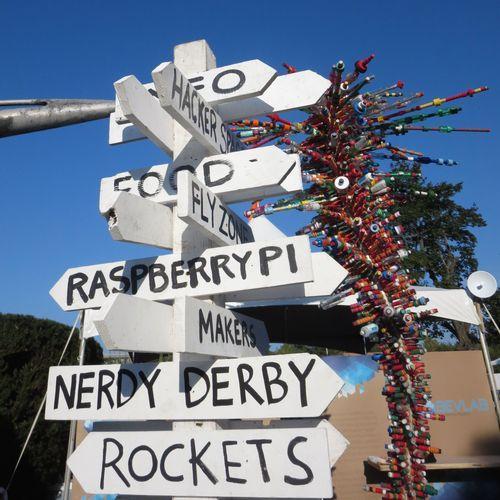 (Photos by Rob Pegoraro/Yahoo Tech)
(Photos by Rob Pegoraro/Yahoo Tech)
Some 85,000 people paid up to $40 a ticket to get their weird on at the World Maker Faire in New York last weekend, and they could not have come away disappointed. These were among the sights at Make magazine’s celebration of do-it-yourself craftiness, computing, and kitsch at the New York Hall of Science in Queens:
• A 17-foot-tall 3D printer from SeeMeCNC named PartDaddy.
• Not-A-Camera, a laser-cut wood illustration of a camera that itself concealed a lens, circuit board, and microSD Card slot.
• The enormous robotic giraffe I last saw lumbering around the South Lawn of the White House.
• 3D-printed prosthetic hands for children developed by the e-NABLE project.
• The Sashimi Tabernacle Choir, an art car encrusted with crustaceans and fish, all of which danced and wriggled in time to such tunes as Handel’s Messiah.
• Popcade,
a 50 percent scale arcade game machine that played such classics as
Defender and Joust (fortunately, it did not require half-size quarters).
• A swimmable mermaid suit, made to order out of silicone. Creator Pearlie Mae offered this warning about wearing one: “It’s very exfoliating.”
As delightfully strange as all
that was, it fit my expectations from visits to earlier, smaller Maker
Faires. But there were other parts I didn’t see coming.

Giant companies like Maker FaireCorporations
showed up in force at the World Maker Faire, the fifth in a row here:
Disney, Intel, LG, Toyota, Ford, and Pepsi all had major exhibits.
And while the interest of an Intel should be obvious (at CES, it introduced a tiny computing module, Edison,
made in part for the tinkering market), firms like Disney and Pepsi
don’t exactly stand out as champions of DIY and remix culture.
Maker Faire founder Dale
Dougherty acknowledged the potential for awkwardness during a Q&A
session with the media on Sunday. “I think they’re here to learn as
well,” he said. “You look at the LG booth — it doesn’t look like their
CES booth.”
Indeed, the Korean electronics
conglomerate had a long line of people waiting to build a tiny circuit
board with a soldering iron. And Disney’s tent was mostly occupied by
such guest exhibitors as littleBits, which makes tiny electronics kits for kids and other curious types; no space was given over to its movies or TV shows.
“We do our best to help them
understand what the maker movement is,” Dougherty said. “Ideally, it’s a
remixing of some corporate cultures with the maker movement.”

It’s not just about 3D printing and ArduinoThe earlier, smaller Maker Faires I’d attended leaned heavily on 3D printers, tiny gadgets built around Arduino microcontrollers, interactive LED sculptures, and other projects that involve computer code, circuit boards, or both.
Here, however, I found myself spending a soothing 45 minutes getting an introduction to crocheting in the NeedleArts Zone. The analog side of Maker Faire also emerged at Bash the Trash,
a project from Hastings-on-Hudson, N.Y., that makes musical instruments
out of junk. For example, a thick cardboard tube, a Styrofoam box, a
scrap piece of wood, some old metal wire, and a turnbuckle had become a
violin of sorts.
At Pop-Up Repair,
members of this New York group fixed random objects for free. While I
watched, one volunteer used a soldering iron to fix a set of earrings;
another wielded pliers to twist wire to patch a tear in a belt.
And a tent in a field attracted a crowd for lock-picking tutorials
— not to break into other people’s homes, but to learn about how
pin-tumbler locks work. As a slide show emphasized, the first rule of
lock-picking is “Do not pick someone else’s locks”; the second rule is
“Do not pick your locks … if you rely on them.”
At a Maker Faire, you’re more
likely to be asked, “What do you make?” than “What do you do?” I was a
bit leery of that question, since I don’t code and only picked up a
soldering iron for the first time last month. But seeing all this non-electronic handiwork made me rethink things: Well, I do bake bread and (occasionally) brew beer, so maybe I am a maker after all.

The world is going the other wayDuring
that media Q&A, Dougherty spoke about the situation Maker Faire was
created to work against: “Things arrive as packages; we don’t get to
put them together.”
Since the first Maker Faire in 2006,
many things have made life easier for the tinkerer. Open-source
software, where anybody can inspect and improve a program’s
instructions, is no longer a foreign concept; the cost of small-batch
manufacturing with 3D printers, laser cutters, and other computerized
tools has dropped dramatically; crowd-funding sites have radically
opened up financing for hardware hackers.
But the mainstream gadget
business keeps making products that are less open to tinkering and
repair by their users. The original vision of the Macintosh — an appliance computer in a sealed case — looks more and more like the industry standard.
And I can’t really complain,
since I’ve bought into this trend. The phone I used to take notes on all
weekend has a battery I can’t replace and storage I can’t expand, and
the laptop tucked into my bag doesn’t have a single internal component I can swap out or upgrade.

